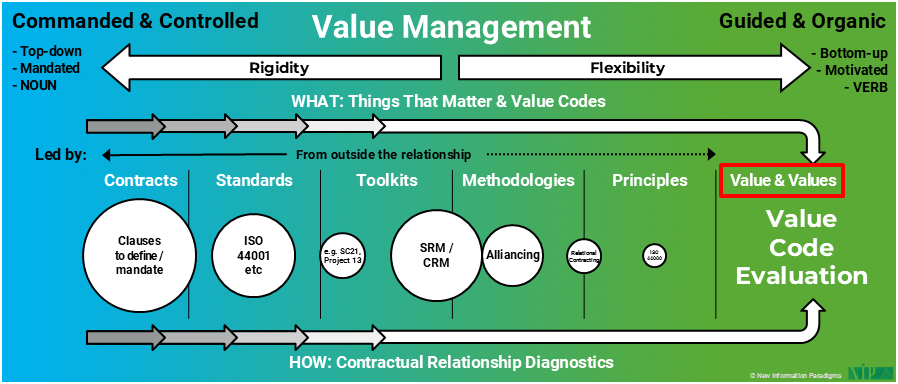Value Management: How to Avoid Being Overwhelmed

If they don’t realize it already, they will soon: anyone engaged in relationships is becoming overwhelmed by the difficulties and Complexity of decisions and trade-offs. Experience-based intuition currently bridges the gap, but it can’t scale and is doomed to fail. Here, we see the ideal and then the pragmatic way to escape this death-spiral, and – in so doing – become truly indispensable to your organization.
Every professional engaged in relationship-based activities – contract managers, relationship managers, project managers, procurement teams, alliance managers, etc – is constantly calling upon their experience and using their intuition to make difficult choices.
In particular, decisions need to be made around the trade-offs between:
- What resources are going to be appropriate?
- How much of them should they be deployed, and for how long?
- Who needs to be engaged?
- When to change the focus?
And so on.
In other words, these professionals are in an environment of constant dynamic change, and – as an understanding of Complexity shows – it’s only to get more and more challenging.
The Looming Death-Spiral
Now calling upon intuition – based on experience – is invaluable, but it’s not scalable:
- It’s locked in individuals’ heads, making it hard to share, spread and scale.
- There comes a point where the demands on individuals overwhelms them.
These challenges and dilemmas affect professionals everywhere but those engaged in relationship-based professions are the first to experience the full extent of them.
Why?
Because requirements for coordination are especially pressing in relationships, growing exponentially and creating swathes of purposeless or less purposeful engagement, conversations, confusion, and so on…
…all driven by an ever expanding stakeholder population with no shared agenda to work to.
There is no structure, content or processes to manage Value and values, and, as a result, there’s been no structured approach to value management – it’s dispersed, assumed, uncoordinated and so on.
There Is a Way Out
However, there is a way out and it involves encoding much of what has previously been taken for granted, left unsaid, and not encapsulated or embodied within a systematically framework (i.e. structured, organized, ordered, comprehensive) that enables what is valuable to be articulated, shared, measured, actionable and adaptable.
In other words, Value Management.
At this point, individuals may feel they are letting go of indispensability – “my organization needs me; I feel wanted; knowledge is power” – but this is entirely short-sighted because, as we’ve seen, this mode of indispensability is only temporary before becoming swamped and overwhelmed.
True indispensability comes only through stepping out of this pattern, taking ownership of – and responsibility for – Value and empowering others to act effectively by establishing and managing the shared Value-led agenda.
How does this happen?
The Ideal Way Out
Well, ideally, teams, functions and organizations would identify the Things That Matter to both their customers and to them – preferably at the outset – factor them out, capture them in Value Codes and then ensure that these Things That Matter are then present and incorporated into any and all activities.
All agreements, be they external and formal – such as contracts, alliance agreements, service level agreements, etc – or internal and informal commitments, would then take account of and include the Value-releasing discoveries made through the Things That Matter process.
The same would be true for the day-to-day activities within any department, function or aspect of the business; again, ideally each should have the thought-through Things That Matter captured, regularly measured and acted upon.
The Pragmatic Way Out
However, in practice, most organizations are where they are at the point that they experience becoming overwhelmed, and that means they have:
- A hierarchical structure.
- Formalized processes and procedures.
- Relatively fixed roles.
- Pervasive relationships.
They therefore have to start with the current state of affairs, and effectively ‘work forward’ from what already exists – e.g. if there’s a contract already in place, it makes sense to complement the terms and obligations of that contract with the additional intangible factors that reflect the Things That Matter to all parties.
In departmental roles, again it makes sense then for the Things That Matter in that particular instance or situation to be articulated and effectively bolted on and incorporated into best practice.
Whilst it’s not ideal to start where you are and bolt on in this way, it may turn out to be the only practical way forward, and this process of progressing from the current state can be envisaged as follows:

In other words, recognize what’s already there – in all cases, at least a contract – and start building on it with Things That Matter and Value Codes that go beyond that existing scope.
By cautiously adding to what’s already there – and showing how this can be made scalable – the Value Management approach will be proven and the way paved for transformation: gradual, pragmatic transformation to begin with, but also the source of true indispensability for those that do this work.

